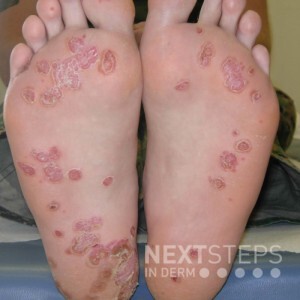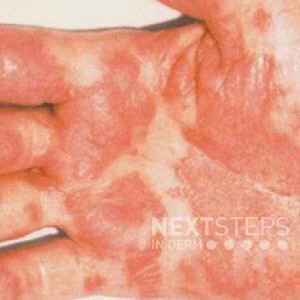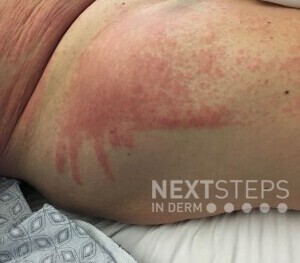Foot Lesions – Friday Pop Quiz 11/5
 In addition to the lesions seen on the feet of this young man he also had geographic tongue, erythematous plaques on his penis and arthritis, what HLA type is associated with this syndrome?
A. HLA-B27
B. HLA-B51
C. HLA-DR1
D. HLA-DR3
E. HLA-DQW2
To find out the correct answer and read the explanation, click here.
Brought to you by our brand partner Derm In-Review. …
In addition to the lesions seen on the feet of this young man he also had geographic tongue, erythematous plaques on his penis and arthritis, what HLA type is associated with this syndrome?
A. HLA-B27
B. HLA-B51
C. HLA-DR1
D. HLA-DR3
E. HLA-DQW2
To find out the correct answer and read the explanation, click here.
Brought to you by our brand partner Derm In-Review. …
 In addition to the lesions seen on the feet of this young man he also had geographic tongue, erythematous plaques on his penis and arthritis, what HLA type is associated with this syndrome?
A. HLA-B27
B. HLA-B51
C. HLA-DR1
D. HLA-DR3
E. HLA-DQW2
To find out the correct answer and read the explanation, click here.
Brought to you by our brand partner Derm In-Review. …
In addition to the lesions seen on the feet of this young man he also had geographic tongue, erythematous plaques on his penis and arthritis, what HLA type is associated with this syndrome?
A. HLA-B27
B. HLA-B51
C. HLA-DR1
D. HLA-DR3
E. HLA-DQW2
To find out the correct answer and read the explanation, click here.
Brought to you by our brand partner Derm In-Review. … 

 A 42 year-old woman has the findings pictured, as well as erythematous patches on the upper chest and shoulders. No Raynaud's, polyarthritis, pulmonary, or cardiac involvement is noted. Which antibody might you expect to be present in this patient?
A. Anti-SRB
B. Anti-Jo-1
C. Anti-Mi-2
D. Anti-Ku
E. Anti-La
To find out the correct answer and read the explanation, click here.
…
A 42 year-old woman has the findings pictured, as well as erythematous patches on the upper chest and shoulders. No Raynaud's, polyarthritis, pulmonary, or cardiac involvement is noted. Which antibody might you expect to be present in this patient?
A. Anti-SRB
B. Anti-Jo-1
C. Anti-Mi-2
D. Anti-Ku
E. Anti-La
To find out the correct answer and read the explanation, click here.
…  A 25 year-old previously healthy man presents with the skin findings shown, urethritis, and one month of peripheral arthritis. Which of the following is true regarding this condition?
A. Females and males are equally affected
B. A chronic deforming arthritis occurs in 20%
C. TNF-alpha inhibiting agents have no role in the treatment of this condition
D. Patients must have urethritis …
A 25 year-old previously healthy man presents with the skin findings shown, urethritis, and one month of peripheral arthritis. Which of the following is true regarding this condition?
A. Females and males are equally affected
B. A chronic deforming arthritis occurs in 20%
C. TNF-alpha inhibiting agents have no role in the treatment of this condition
D. Patients must have urethritis …  A 57 year-old-female is post-op day 2 from a knee replacement. Dermatology is consulted for the dermatitis seen here. It is pruritic, and has not responded to 1% hydrocortisone. What is the most likely etiology of the physical findings?
A. Allergic contact dermatitis to a soap or other topical application
B. Irritant contact dermatitis due to excessive rubbing during the cleansing proces …
A 57 year-old-female is post-op day 2 from a knee replacement. Dermatology is consulted for the dermatitis seen here. It is pruritic, and has not responded to 1% hydrocortisone. What is the most likely etiology of the physical findings?
A. Allergic contact dermatitis to a soap or other topical application
B. Irritant contact dermatitis due to excessive rubbing during the cleansing proces …  On this Mnemonic Monday, we challenge you to remember the layers of the hair follicle from inner to outer -Medulla, Cortex, Cuticle, Huxley/Henly, Outer Root Sheath, and Glassy/Vitreous membrane with the following mnemonic:
My Cortex Cuts Huxley the Hen’s Outer Hair with Glass
M- Medulla
Cortex- Cortex
Cut(s)- Cuticle
Huxley- Huxley’s layer
Hen- Henley’s layer
Outer- Outer …
On this Mnemonic Monday, we challenge you to remember the layers of the hair follicle from inner to outer -Medulla, Cortex, Cuticle, Huxley/Henly, Outer Root Sheath, and Glassy/Vitreous membrane with the following mnemonic:
My Cortex Cuts Huxley the Hen’s Outer Hair with Glass
M- Medulla
Cortex- Cortex
Cut(s)- Cuticle
Huxley- Huxley’s layer
Hen- Henley’s layer
Outer- Outer …